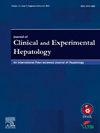Unearthing TULP3 Mutation as a Rare Cause of Cryptogenic Cirrhosis: A Case Report and Review of the Literature
IF 3.3
Q2 GASTROENTEROLOGY & HEPATOLOGY
Journal of Clinical and Experimental Hepatology
Pub Date : 2025-03-08
DOI:10.1016/j.jceh.2025.102542
引用次数: 0
Abstract
Whole-exome sequencing may help unearth uncommon monogenic causes of cryptogenic cirrhosis and portal hypertension. Tubby-like protein 3 (TULP3) gene encodes the tubby domain family of proteins, mutations of which is associated with progressive degenerative disease of major organs such as kidney, heart, and liver. Here we report a case of a young male with decompensated cirrhosis who was ultimately identified with homozygous pathogenic splice donor variant c.492+1G > A in intron 5 of TULP3 gene.
发现TULP3突变是一种罕见的隐源性肝硬化的原因:一个病例报告和文献复习
全外显子组测序可能有助于发现罕见的单基因原因隐源性肝硬化和门静脉高压症。tubby -like protein 3 (TULP3)基因编码tubby结构域蛋白家族,其突变与肾脏、心脏和肝脏等主要器官的进行性退行性疾病有关。在此,我们报告一例患有失代偿性肝硬化的年轻男性,最终被鉴定为纯合子致病性剪接供体变异c.492+1G >;TULP3基因5内含子中的A。
本文章由计算机程序翻译,如有差异,请以英文原文为准。
求助全文
约1分钟内获得全文
求助全文
来源期刊

Journal of Clinical and Experimental Hepatology
GASTROENTEROLOGY & HEPATOLOGY-
CiteScore
4.90
自引率
16.70%
发文量
537
审稿时长
64 days
 求助内容:
求助内容: 应助结果提醒方式:
应助结果提醒方式:


